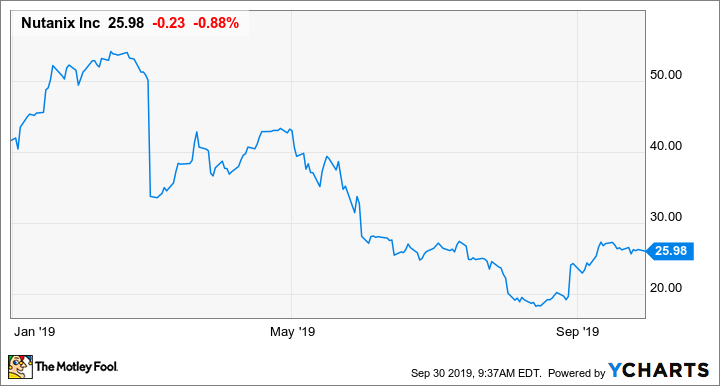It has been nearly two years since Nutanix (NTNX 1.85%) started pivoting to a software-centric business model. Wall Street was overjoyed to see the cloud computing services provider switch to a high-margin model, but once the initial euphoria died down and the company's top- and bottom-line performance started dipping below expectations, its stock took a hit.
However, Nutanix gave investors some relief recently. The company beat expectations when it released its fiscal 2019 fourth-quarter results and the stock rallied. But it also warned investors to be prepared for more transition-related pain in fiscal 2020 despite impressive growth in the subscription side of the business. Let's see why.

Image source: Getty Images.
Nutanix warns of higher top-line compression
Nutanix's recent stock rally could fizzle out soon, as the company's top line is expected to take a big hit thanks to its transition to a subscription-based business model. CFO Duston Williams made this very clear over the latest earnings conference call: "This guidance also assumes an estimated 20% or approximately $170 million to $200 million top-line compression related to our subscription transition, as well as approximately $45 million less than hardware billings and hardware revenue versus the current Street estimates."
The company was originally anticipating a top-line compression of 10% because of the transition. But because its customers are now signing shorter three-year deals as compared to five-year deals, Nutanix is witnessing a slowdown in the up-front revenue that it receives from the initial contract.
More specifically, Nutanix's average duration for its subscription contracts stood at 3.7 years in the fourth quarter as compared to 3.9 years in the prior-year period. However, the company did point out that the reduction in the average contract length is more because of a movement from five-year to three-year deals, and not because of an increase in one-year deals.
What's more, Nutanix's forecast of software and support revenue between $1.3 billion and $1.4 billion this fiscal year represents a high-single-digit increase at the midpoint of the guidance range. So had it not been for the transition-related issues, Nutanix's top-line performance would have been much better.
However, investors need to look at a few other metrics to understand that the problems are only temporary in nature and that Nutanix is setting itself up for impressive long-term growth.
Don't miss the big picture
Nutanix's pivot toward a software-centric business model has reaped rich rewards on the margin front. The company exited the fourth quarter of fiscal 2019 with a non-GAAP gross margin of 80%. That's a terrific improvement over the 62.6% non-GAAP gross margin reported by Nutanix in Q4 of fiscal 2017.
The cloud specialist's gross margin profile should get better in the future, as it aims to get 75% of its total billings from subscriptions by calendar 2021, up from 71% at the end of the latest fiscal year. And it should be able to achieve that goal given the impressive pace of deal-making it reported in the latest quarter.
Nutanix added 990 new customers in the fourth quarter of fiscal 2019. Management said that this was the highest number of new customer additions it has witnessed in the past six quarters. What's more, the company struck 58 deals that were worth more than $1 million during the quarter, and 11 of those customers had struck $1 million-plus deals in Q3 as well. The number of $1 million-plus deals was 50 in the fiscal third quarter.
Moreover, Nutanix exited the fourth quarter of 2019 with 46 customers with a lifetime bookings value of over $10 million. A year ago, this number stood at just 26. The lifetime value indicates the revenue that a company expects to generate from a client over the length of the contract. So an increase in the number of customers with a strong lifetime value indicates that Nutanix's subscription products are gaining impressive end-market traction.
The final metric that investors need to look at is deferred revenue. Nutanix ended fiscal 2019 with $910 million in deferred revenue, a terrific jump of 44% over the previous fiscal year. Deferred revenue is the amount of money a company has already received for services that will be provided at a later date.
For comparison, Nutanix's actual revenue increased 6.8% last fiscal year. The rapid increase in deferred revenue is a clear sign that Nutanix's top-line growth will gain momentum in the long run. The company is already calling for high-single-digit revenue growth this fiscal year, and consensus estimates compiled by Yahoo! Finance indicate that its top-line growth could hit more than 27% in fiscal 2021.
So even though Nutanix faces near-term uncertainty on account of the transition to a subscription-based model, it could be a good long-term stock pick.







